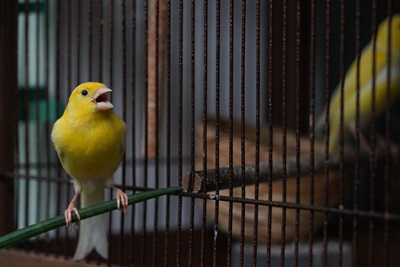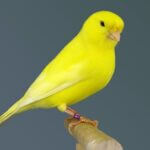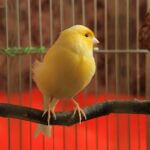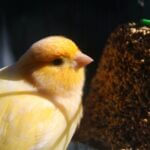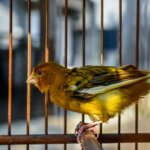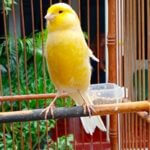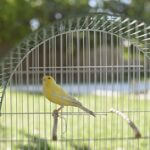Pet canaries can live to be 10-15 years old, which is often longer than many people expect to have them.
For this reason, it’s common to find adult canaries that require rehoming. If you get your canary as an adult from a pet store or animal shelter, it can be hard to know precisely how old it is.
Don’t just assume that your canary is energetic and playful as a sign that it’s also young.
How Old is My Canary?
Many bird enthusiasts find it hard to effectively determine the age of a bird acquired as an adult.
According to ILAR Journal, birds age differently than most small animals. Your canary could live three times as long as the average mammal of similar size.
This extended lifespan means that canaries (and other birds) can seem relatively youthful, even when they’re approaching seniority.
The easiest way to be certain of the age of a canary is when the breeder or previous owners were members of a canary club. In these cases, the bird should have a ring around its leg.
The color of that ring indicates the age of the bird. Unfortunately, not all canaries have a ring.
Differences Between Young and Old Canaries
Physically and behaviorally, there are several differences between young and older canaries reaching the end of their lifespan.
The canary life cycle is as follows:
- Between 15 and 27 days after hatching, a canary is a fledgling.
- Between 28 days after hatching and its first molting, a canary will wean and become independent.
- After molting, a canary is a juvenile.
- At 8 months old, a canary is sexually mature. Some canaries may mature at 6 months, while others may not mature until 10 months of age.
- Canaries can live to be 10-15 years of age but may start to slow down at around 6 years of age.
- When a canary reaches 8 or 9, it should be considered a senior canary.
Once fully grown, the average canary will be 3-4 inches long. Therefore, if your canary is around this size and has bright plumage and shiny talons, you can assume it’s fully mature but not yet a senior.
Consider more specific features if you want a better idea of a canary’s age. Also, you can ask an avian vet to assess the canary for you.
How To Age A Canary
If you want to determine your canary’s age without talking to a vet or avian expert, you should examine the build and shape of your canary.
For example, immature canaries are much smaller and have a different body structure than mature birds.
These more prominent features can also help you estimate a canary’s age:
Claws
Evaluate the shape, condition, and color of the canary’s claws.
Young and adolescent canaries have healthy, shiny claws and firm, bright skin on their feet. As a canary ages, its claws become dull and brittle, and its foot scales thicken or wrinkle.
This is a natural part of aging and doesn’t reflect poor health. However, younger canaries have experienced less wear and tear over time, so their legs and claws will reflect this fact.
Feather Coloration
Young canaries have bright and bold feathers, while older canaries have more muted feathers.
Older canaries may have more fragile feathers. According to Karger, just as humans experience hair thinning and loss of luster with age, birds also experience changes in their plumage as they age.
This is a natural result of their metabolism slowing down and their molts becoming less efficient.
Of course, premature thinning or color loss in canary feathers can be a sign of illness, as can feather loss and picking.
So, if other signs point to a young bird, but it has dull, faded, or thinning feathers, consult a vet.
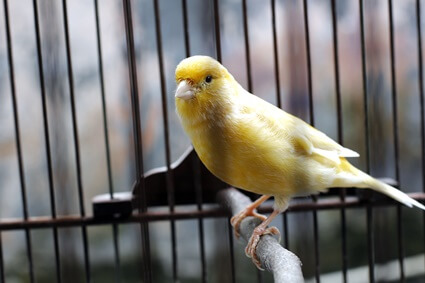
Genitals
The difference between male and female canary genitals is subtle and most obvious during the breeding season.
Sexually mature male canaries will have prolonged and slightly elongated vents, while female canaries will have flatter and rounded ones.
You can be certain that your canary is at least 8 months to 1 year old, as this is when canaries reach sexual maturity (on average).
Body Structure
Juvenile, adolescent, and elderly canaries all have different body structures.
Juvenile canaries will, of course, be smaller and brighter. In contrast, mature adults will be larger and have fully formed wings and genitalia.
Elderly canaries may start to look frail and have visible damage to feathers or other cosmetic scars.
Of course, this depends on the kind of life they’ve lived. Nonetheless, you can expect even a well-cared-for canary to show signs of aging.
When Will My Canary Be Considered Geriatric?
It can be hard to get an actual age for your canary beyond its sexual maturity or the presence of an identifying leg ring. Nonetheless, certain physical changes indicate that a canary is becoming geriatric.
According to Behavioral and Neural Biology, a canary’s song changes seasonally, but you may also notice changes in your canary’s song as it gets older.
As with all animals, canaries are most energetic and bright when young.
A young canary will have an excited and loud song. In contrast, an older bird might sing more quietly and less regularly, and it’ll have less energy and strength to sing like it used to.
This lack of energy will also impact how they interact and play.
Here are the physical changes that you can expect as your canary reaches seniority:
Eyes
A bird’s eyes say a lot about how old it is.
Young birds will have darker irises than older ones, although this isn’t always the case. In some situations, very old canaries can end up with entirely white eyes.
This is rare in canaries and is more likely to occur in birds with long lifespans.
For example, this often occurs in parrots. When your canary reaches the senior stage, it’s more likely to have dark irises or get a white sheen in its eyes.
Beak
Alongside the state and color of a canary’s talons and feet, the color and condition of its beak can be an indicator of age.
These changes can be extremely subtle and vary from species to species. For example, some canaries’ beaks may get darker as they age or take on a different hue.
Very old canaries are more likely to have heavily scaled, darker-colored feet. If the scales appear grey or irregular in shape and size, this can signify illness rather than advanced age.
If you get a canary that’s already matured and the previous owner wasn’t a member of a canary club, it may not be possible to precisely determine its age.
However, a veterinarian or avian expert can give you an estimate that helps you give the pet care that is appropriate for its age.

